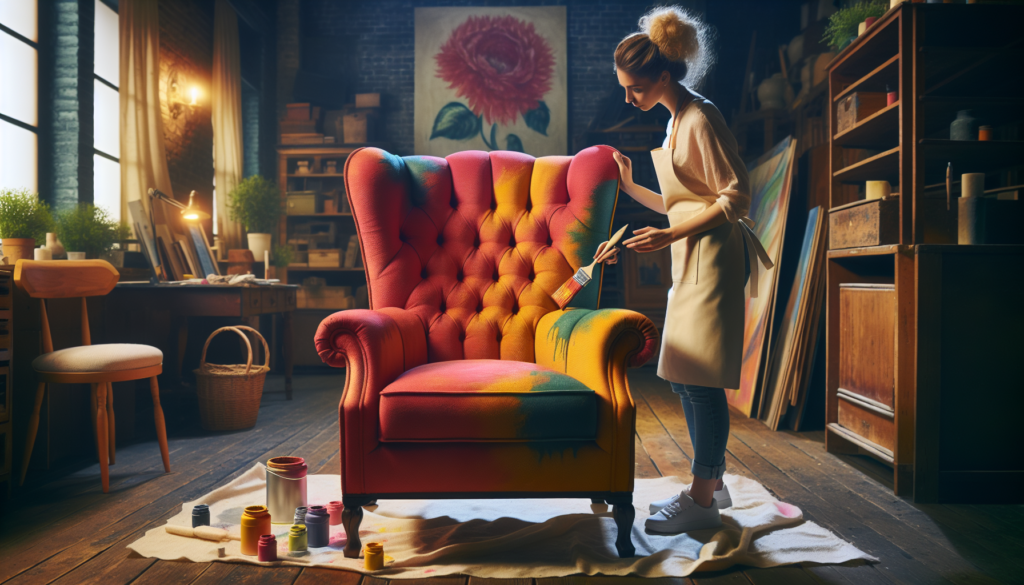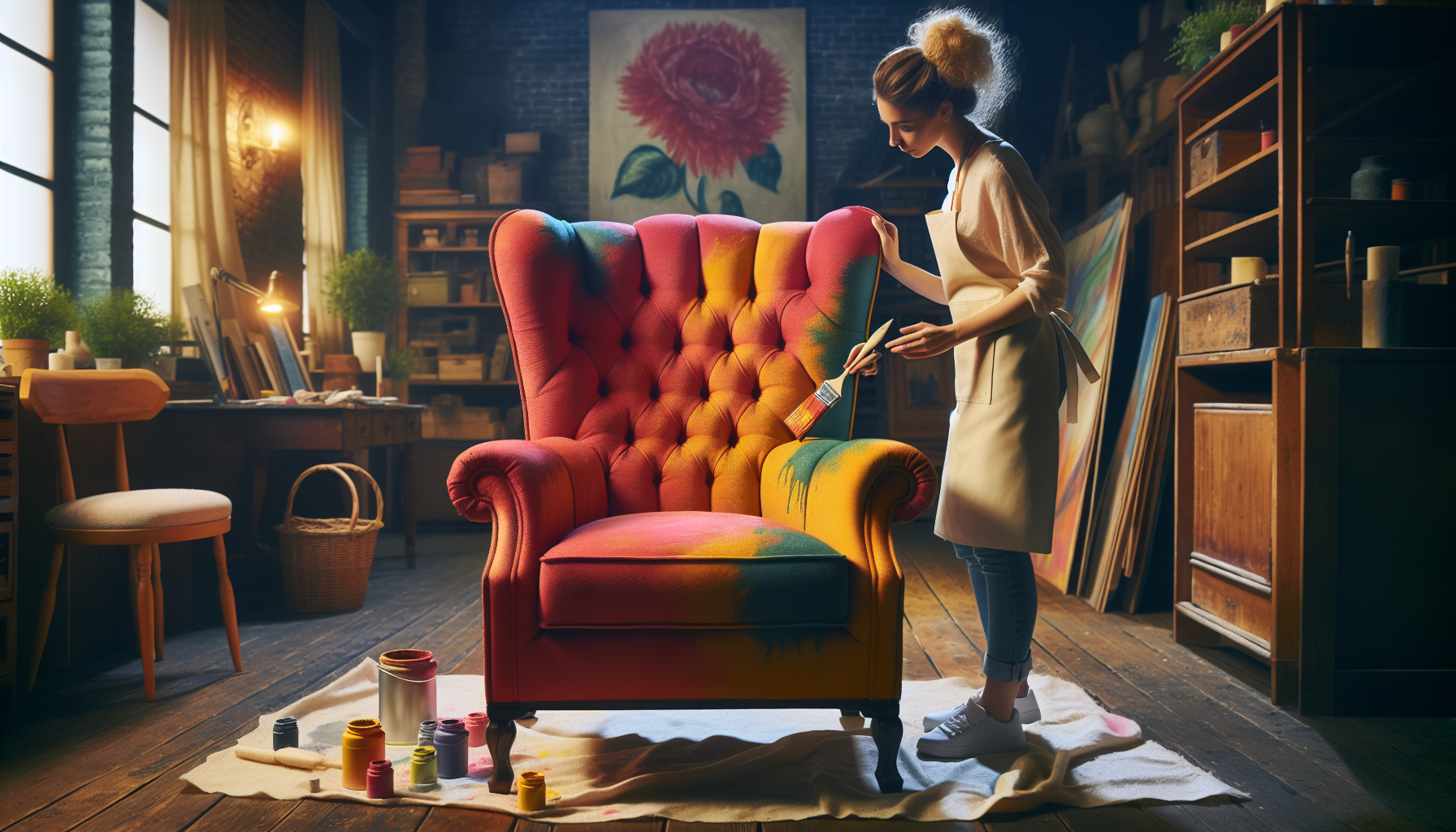In this article, you will learn the step-by-step process of painting upholstery with chalk paint. By utilizing this innovative technique, you can transform worn-out and outdated furniture into stylish pieces that seamlessly blend with your interior decor. Whether you have a favorite armchair that has seen better days or a sofa that no longer matches your aesthetic preferences, painting upholstery with chalk paint offers a cost-effective solution that allows you to breathe new life into your furniture. Discover how to achieve professional-looking results by following these straightforward instructions.

Choosing the Right Chalk Paint
Understanding Chalk Paint
Chalk paint is a versatile and popular option for painting upholstery. It is a type of paint that has a matte and chalky finish, giving furniture a vintage and well-worn look. Understanding the characteristics of chalk paint is important before embarking on any upholstery painting project. Chalk paint is known for its excellent coverage, exceptional adhesion to various surfaces, and minimal prep work required. It is also non-toxic and easy to use, making it a favorite among DIY enthusiasts and professional painters alike.
Selecting Colors
When choosing chalk paint for your upholstery project, consider the color scheme of the room and the overall aesthetic you want to achieve. Chalk paint comes in a wide range of colors, from neutral tones to vibrant shades, allowing you to transform your upholstery into a statement piece or seamlessly blend it with your existing decor. It is advisable to select a color that complements the fabric type and the style of your furniture, ensuring a cohesive and visually pleasing result.
Considering the Fabric Type
Not all fabrics are suitable for painting with chalk paint. It is essential to consider the fabric type before proceeding with the project. Chalk paint works best on absorbent fabrics such as cotton, linen, and canvas. These fabrics allow the paint to adhere effectively and provide a smooth finish. However, if you have upholstery made of non-absorbent fabrics like silk or polyester, it may be more challenging to achieve a satisfactory result. For such fabrics, it is advisable to consult a professional or consider alternative upholstery options.
Preparing the Upholstery
Cleaning the Surface
Before painting the upholstery, it is crucial to clean the surface thoroughly. Remove any dust, dirt, or stains from the fabric using a vacuum cleaner or a soft brush. You can also use a mild upholstery cleaner or a mixture of warm water and liquid dish soap to gently cleanse the fabric. Ensure that the fabric is completely dry before proceeding to the next step.
Removing Upholstery Stains
If there are stubborn stains on the upholstery, it is essential to treat them appropriately. Depending on the type of stain, you can use specialized upholstery stain removers or homemade solutions. Follow the manufacturer’s instructions or guidelines when using stain removers, and test them on a small, inconspicuous area of the fabric first to ensure they do not cause any discoloration or damage. Thoroughly rinse and dry the fabric after treating the stains.
Sanding the Fabric
Sanding the fabric is an optional step that can help improve the adhesion of the chalk paint. Lightly sanding the fabric with a fine-grit sandpaper can remove any rough texture or loose fibers, allowing the paint to adhere more effectively. Be careful not to sand too aggressively or damage the fabric. After sanding, remove any sanding residue by vacuuming or gently brushing the fabric.
Preparing the Area
Covering the Surrounding Areas
Before applying chalk paint to your upholstery, it is crucial to protect the surrounding areas from accidental paint splatters or spills. Cover nearby furniture, floors, and walls with plastic or drop cloths to create a barrier and prevent any unwanted mess. This will save you time and effort in cleaning up later.
Laying a Drop Cloth
Laying a drop cloth over the upholstery itself will catch any drips or spills that may occur during the painting process. Make sure the drop cloth is securely placed, covering the entire area you will be working on. This extra layer of protection will prevent any paint from seeping through and potentially staining the fabric beneath.
Removing Obstacles
Take the time to remove any obstacles such as buttons, buckles, or cushions from the upholstery. These can hinder the painting process and prevent the paint from adhering evenly. Set them aside in a safe place and reattach them after the painting is complete.
Applying Chalk Paint
Mixing the Chalk Paint
Before applying chalk paint to your upholstery, it is essential to mix it thoroughly. Some chalk paints may separate or settle over time, so give the can a good shake or stir until the paint is well-blended. Proper mixing ensures consistent color and texture throughout the project.
Testing the Paint on a Scrap Fabric
Before painting the entire upholstery, it is advisable to test the chalk paint on a small scrap piece of fabric or an inconspicuous area of the upholstery. This will allow you to assess the paint’s coverage, adhesion, and color on the specific fabric type. It will also help you determine whether any adjustments or modifications need to be made before proceeding with the entire project.
Using a Spray Bottle for Thinning the Paint
Chalk paint can be thick in its natural state, especially if it has been sitting for a while. If the paint seems too thick or difficult to apply evenly, you can thin it down by adding water. Use a clean spray bottle to mist the paint lightly while stirring it until you reach the desired consistency. Be cautious not to add too much water, as it can affect the paint’s adhesive properties and overall finish.

Priming the Fabric
Applying the First Coat
Before diving into multiple coats of chalk paint, start with a single, even coat to prime the fabric. Use a brush or foam roller to apply the paint in long, smooth strokes, following the fabric’s natural grain. Ensure that the paint is evenly distributed and covers the surface entirely. The first coat will provide a base for subsequent layers and improve the overall coverage and adhesion.
Using a Small Brush for Detailing
If your upholstery has intricate details or hard-to-reach areas, use a small brush for better control and precision. A small brush will allow you to navigate corners, seams, and decorative elements with ease, ensuring every part of the upholstery receives an even coat of paint.
Allowing Drying Time in Between Coats
After applying the first coat, allow the paint to dry completely before applying additional coats. The drying time may vary depending on factors such as humidity and the fabric type. It is important to follow the manufacturer’s instructions regarding drying time and let each coat dry thoroughly before proceeding. Rushing the process may lead to uneven coverage or smudging.
Applying Additional Coats
Achieving Desired Coverage
After the priming coat has dried, assess the coverage and determine if additional coats are needed. Apply subsequent coats of chalk paint using the same technique as the first coat, ensuring even coverage and smooth application. Depending on the desired color intensity and the fabric’s original color, you may require multiple coats to achieve the desired look.
Creating Texture with Brushstrokes
Chalk paint allows for creative expression and the opportunity to add texture to your upholstery. Experiment with different brushstrokes, such as crosshatch, stippling, or feathering, to create unique patterns and visual interest. Be mindful of the overall effect you want to achieve and use brushstrokes that enhance the fabric’s texture and the furniture piece’s style.
Tackling Visible Streaks
If you notice any visible streaks or unevenness in the paint during the application process, don’t worry. Chalk paint often settles and evens out as it dries. Avoid overworking the paint or trying to correct every imperfection while it is wet. Allow it to dry completely, and if necessary, lightly sand any rough spots before proceeding to the next step.
Sealing the Paint
Choosing the Right Sealer
While chalk paint has excellent adhesion and durability, it is recommended to seal the painted upholstery to protect it from wear and tear. There are various sealers available, including clear wax or polyurethane. Consider the level of protection required for your upholstery and select a sealer that is compatible with chalk paint and suitable for the fabric type. Read the manufacturer’s instructions carefully before applying the sealer.
Applying a Clear Top Coat
Once you have chosen the appropriate sealer, apply a clear top coat over the painted upholstery. Use a brush or foam roller to evenly spread the sealer, following the fabric’s grain and ensuring complete coverage. The top coat will provide an added layer of protection, making the painted upholstery more resistant to stains, spills, and fading. Allow the sealer to dry completely before using the furniture.
Checking Durability and Protection Levels
After the top coat has dried, assess the durability and level of protection that the sealer provides. Perform a simple test by gently rubbing a small, inconspicuous area of the painted upholstery with a damp cloth. If the paint remains intact and there is no transfer of color, it indicates that the sealer has effectively protected the upholstery. Regularly monitor the condition of the painted upholstery and reapply the sealer as needed.
Caring for the Painted Upholstery
Avoiding Abrasive Cleaning Methods
To maintain the longevity and appearance of painted upholstery, it is essential to avoid abrasive cleaning methods. Harsh chemicals, scrub brushes, or abrasive sponges can damage the paint finish and the fabric itself. Instead, opt for gentle cleaning techniques to remove dirt or stains.
Using Mild Soap and Water for Cleaning
For routine cleaning, use a mild soap and water solution to gently clean the painted upholstery. Apply the solution with a soft cloth or sponge, making sure not to saturate the fabric excessively. Blot the area dry with a clean towel and allow it to air dry completely before using the furniture. This approach will help preserve the paint’s finish and prevent any potential damage.
Preventing Heat and Sun Exposure
Direct heat or prolonged exposure to sunlight can fade or discolor the paint on upholstery. To prevent this, avoid placing painted upholstery in areas where it will be exposed to direct sunlight or excessive heat sources. Consider using curtains, blinds, or UV-protective window films to shield the furniture from harmful rays and maintain the vibrant color of the paint.
Refreshing the Painted Upholstery
Touching Up the Paint Over Time
Over time, painted upholstery may experience wear and tear or minor scratches. To keep your furniture looking fresh and vibrant, periodically touch up areas where the paint may have worn off or become damaged. Lightly sand the affected areas, clean the surface, and apply a small amount of matching chalk paint with a brush or sponge. Blend the touch-up paint seamlessly with the surrounding area for a seamless finish.
Coloring Over Faded Areas
If your painted upholstery begins to fade over time, you can refresh the color by applying a new coat of chalk paint. Choose a color that closely matches the original shade and follow the same application techniques mentioned earlier. Applying a fresh coat of paint will revive the upholstery and bring back its original vibrancy.
Addressing Scratches and Chips
In the event of deeper scratches or chips on painted upholstery, more extensive repair may be required. Assess the severity of the damage and determine whether a professional touch-up or repainting is necessary. Consult a furniture restoration specialist or upholstery professional to ensure the best possible result and to maintain the paint’s overall integrity.
Taking Precautions and Safety Measures
Working in a Well-Ventilated Area
When working with chalk paint, it is important to ensure proper ventilation in the workspace. Open windows or work in an outdoor area to allow fresh air to circulate and minimize exposure to paint fumes. If necessary, wear a respiratory mask or use a fan to help dissipate any lingering odors or vapors.
Wearing Protective Clothing and Gloves
Protective clothing and gloves are essential while painting upholstery. Wear old clothes that you wouldn’t mind getting paint on, and cover exposed skin to avoid contact with chalk paint. Latex or nitrile gloves will protect your hands from any potential skin irritation or chemical reactions. Safety goggles may also be necessary if you are sanding the upholstery or working in a dusty environment.
Using Proper Disposal for Paint and Materials
Once the upholstery painting project is complete, it is important to dispose of any leftover paint, paint cans, and other materials properly. Follow local regulations regarding paint disposal, as some areas may have specific guidelines. Do not pour paint down the sink or drain, as it can contaminate water sources. Instead, take unused paint to a recycling center or donate it to a local community organization if possible.
By following these comprehensive steps, you can successfully paint upholstery using chalk paint and transform your furniture into a work of art. Remember to choose the right chalk paint, prepare the upholstery and work area properly, and apply the paint in thin, even coats. Seal the painted upholstery for added protection and maintain it by using gentle cleaning methods. With the right precautions and safety measures, you can achieve stunning results and enjoy your beautifully painted upholstery for years to come.



